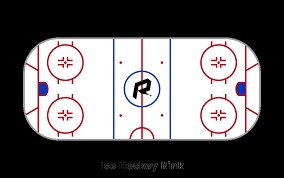By Russ Eddins
Journalism Student

This week I’m offering a glossary that covers the essential parts of hockey every fan should
know, ranging from information about the Ole Miss hockey team to penalties and other terms.
Let’s continue with our Hockey Glossary, Part 3.
The Rink

Zones
The rink is divided into three zones: the defensive zone, the neutral zone, and the offensive zone. The neutral zone is between the blue lines. The defensive and offensive zones are on opposite sides. In the second period, and if the game goes into overtime, the zones are flipped. So if Team A’s offensive zone is on the right side in the first period, their offensive zone will be on the left side in the second period.
The Boards
The boards are plastic material that wraps around the entire rink. Players often “rim” the puck around the boards to keep the puck in the zone when they are about to be pressured out of the zone.
Faceoff Circles/Dots
In sports like soccer and basketball (except at tipoff), a team is given possession of the ball. In hockey, no one is given possession. The referee will drop the puck between two players and they fight for it. Faceoffs can occur in eight different places: the center of the ice, the four dots between the blues line (the neutral zone), and in the middle of the four circles on both ends of the ice.
The Glass
All along the rink, except for the benches, glass runs along the top of the wall. Players will hit one other into the glass. Its primary purposes are to keep the puck in play and to separate the game from the fans. It is not standard glass, though; it’s plexiglass.
The Crease
The blue area on either area of the ice is called the crease. The goalie stays here. It is directly in front of the goal. The goalie cannot be interfered with while in the crease.
The Referee Crease
The red semicircle is called “the referee crease”. Referees go here to discuss a play in question, a penalty, or several penalties that are being assessed simultaneously.
The Goal Line
The red line at either end of the ice is called “the goal line”. For a goal to be scored, the entire puck has to cross the goal line in the goal. The line is there to help the referees determine if a goal was scored or not.
Behind The Goal
The trapezoid behind the goal limits the goalie’s ability to play the puck. When the puck has crossed the goal line, the goalie can only play it if it is in the trapezoid. If the goalie plays the puck when it is behind the goal line and outside of the trapezoid, he will be given a two-minute minor penalty. When goalies are given penalties, the coach will choose another player on the team to take the penalty for the goalie. That means the player chosen by the coach will be in the penalty box instead of the goalie.
Sources
Hockey Rink Lines Explained (with Images) – Gaimday
https://www.rookieroad.com/ice-hockey/the-rink/
Where can the goalie play the puck? (with pictures) – Hockey Answered
NHL Changes: Remove Touch-Icing and Trapezoid; Add Coaches Challenge; Re-Align
What Is Hockey Glass Made Of? Plexiglass in Hockey


